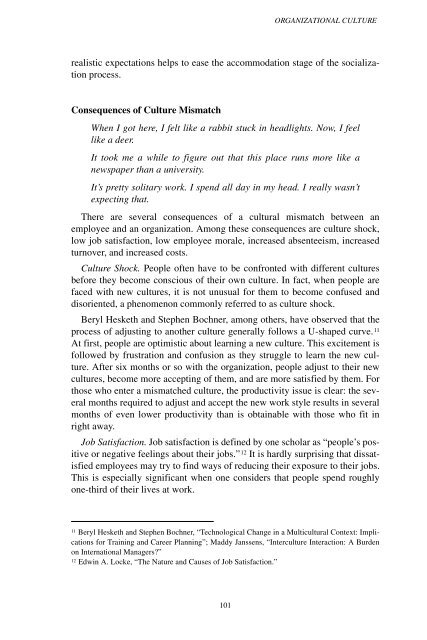Analytic Culture in the U.S. Intelligence Community (PDF) - CIA
Analytic Culture in the U.S. Intelligence Community (PDF) - CIA
Analytic Culture in the U.S. Intelligence Community (PDF) - CIA
You also want an ePaper? Increase the reach of your titles
YUMPU automatically turns print PDFs into web optimized ePapers that Google loves.
ORGANIZATIONAL CULTURE<br />
realistic expectations helps to ease <strong>the</strong> accommodation stage of <strong>the</strong> socialization<br />
process.<br />
Consequences of <strong>Culture</strong> Mismatch<br />
When I got here, I felt like a rabbit stuck <strong>in</strong> headlights. Now, I feel<br />
like a deer.<br />
It took me a while to figure out that this place runs more like a<br />
newspaper than a university.<br />
It’s pretty solitary work. I spend all day <strong>in</strong> my head. I really wasn’t<br />
expect<strong>in</strong>g that.<br />
There are several consequences of a cultural mismatch between an<br />
employee and an organization. Among <strong>the</strong>se consequences are culture shock,<br />
low job satisfaction, low employee morale, <strong>in</strong>creased absenteeism, <strong>in</strong>creased<br />
turnover, and <strong>in</strong>creased costs.<br />
<strong>Culture</strong> Shock. People often have to be confronted with different cultures<br />
before <strong>the</strong>y become conscious of <strong>the</strong>ir own culture. In fact, when people are<br />
faced with new cultures, it is not unusual for <strong>the</strong>m to become confused and<br />
disoriented, a phenomenon commonly referred to as culture shock.<br />
Beryl Hesketh and Stephen Bochner, among o<strong>the</strong>rs, have observed that <strong>the</strong><br />
process of adjust<strong>in</strong>g to ano<strong>the</strong>r culture generally follows a U-shaped curve. 11<br />
At first, people are optimistic about learn<strong>in</strong>g a new culture. This excitement is<br />
followed by frustration and confusion as <strong>the</strong>y struggle to learn <strong>the</strong> new culture.<br />
After six months or so with <strong>the</strong> organization, people adjust to <strong>the</strong>ir new<br />
cultures, become more accept<strong>in</strong>g of <strong>the</strong>m, and are more satisfied by <strong>the</strong>m. For<br />
those who enter a mismatched culture, <strong>the</strong> productivity issue is clear: <strong>the</strong> several<br />
months required to adjust and accept <strong>the</strong> new work style results <strong>in</strong> several<br />
months of even lower productivity than is obta<strong>in</strong>able with those who fit <strong>in</strong><br />
right away.<br />
Job Satisfaction. Job satisfaction is def<strong>in</strong>ed by one scholar as “people’s positive<br />
or negative feel<strong>in</strong>gs about <strong>the</strong>ir jobs.” 12 It is hardly surpris<strong>in</strong>g that dissatisfied<br />
employees may try to f<strong>in</strong>d ways of reduc<strong>in</strong>g <strong>the</strong>ir exposure to <strong>the</strong>ir jobs.<br />
This is especially significant when one considers that people spend roughly<br />
one-third of <strong>the</strong>ir lives at work.<br />
11<br />
Beryl Hesketh and Stephen Bochner, “Technological Change <strong>in</strong> a Multicultural Context: Implications<br />
for Tra<strong>in</strong><strong>in</strong>g and Career Plann<strong>in</strong>g”; Maddy Janssens, “Interculture Interaction: A Burden<br />
on International Managers?”<br />
12<br />
Edw<strong>in</strong> A. Locke, “The Nature and Causes of Job Satisfaction.”<br />
101
















